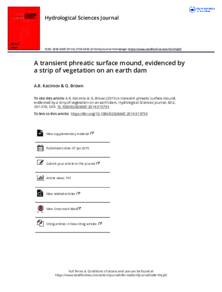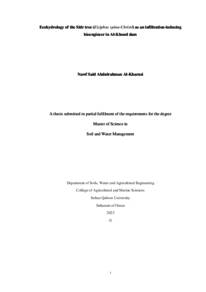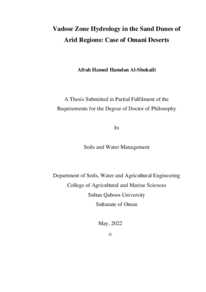Document
A Transient phreatic surface mound, evidenced by a strip of vegetation on an earth dam.
Identifier
DOI: 10.1080/02626667.2014.913793
Contributors
Brown, G., Author
Publisher
Taylor and Francis.
Gregorian
2015-02
Language
English
English abstract
Abstract: On the slopes of the embankment of the Al-Khod groundwater recharge–flood protection dam (Oman), a band of scrub vegetation community emerged after torrential rains and temporary filling of the dam reservoir. Species composition differs markedly on both sides of the embankment, with many exotics found on the reservoir side and more typical gravel-desert species on the outside. Hydro-ecologically, the vegetation is interpreted as the footprint of a temporary storage of water, which is a small-sized groundwater mound within the permeable shoulder of the levee. The levee, as an anthropogenic landform, induces a U-turn (gravitational slumping–lateral seepage–transpirational moisture ascent) topology of seepage. The Lembke method of successive variations of steady states is used in modelling the water table dynamics. In the early stage of the mound decay, outflow through a seepage face of the shoulder is modelled by the Barenblatt slumping parabola of the phreatic-zone part of the flow domain, which is perfectly matched with the Youngs exact solution for a purely horizontal flow through a porous wedge. At the stitching cross-section, the flow rates and saturated depths in the two zones coincide. The late stage of mound evolution is characterized by transpiration by the plant roots projected onto a shrinking free surface, with the Barenblatt and Youngs solutions conjugated but without the outcrop of the saturated mound on the levee slope. Ordinary differential equations for the sliding or descending locus of the intersection of the parabola and the triangle hypotenuse are integrated in a closed form or by the Runge-Kutta method. The dwindling saturated volume and the rate of drainage are obtained. They can be used in assessments of the hydro-ecological sustainability of slope-rooted shrubs (vegetation survival between rare rainfall episodes).
Member of
ISSN
0262-6667
Resource URL
Category
Journal articles




